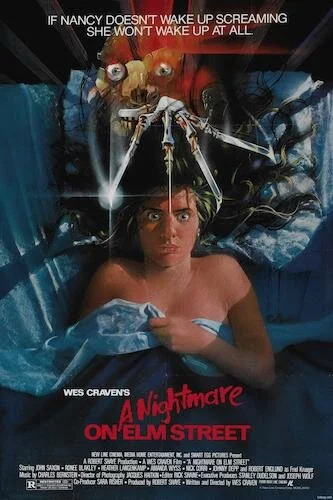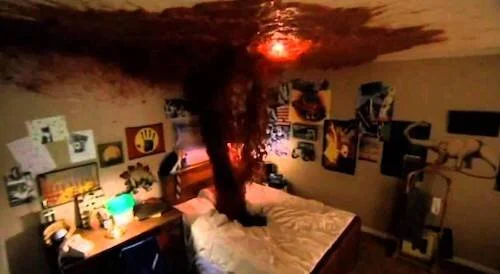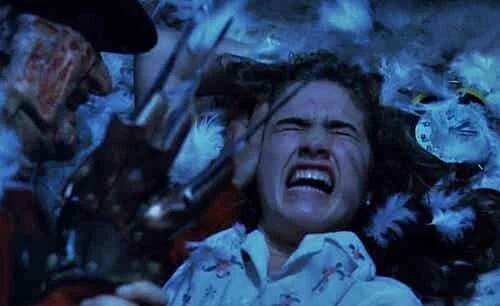A Nightmare on Elm Street: 31 Days of Horror
For all of October, we will review horror films. Submit your requests here, and you may see your picks selected!
Slasher films weren’t becoming fully realized until the ‘80s, despite predecessors like Peeping Tom having existed for quite some time before this decade. Still, this was the time that filmmakers could jump onto a developing horror trend, especially after Halloween and The Texas Chainsaw Massacre — amongst other films — popularized the genre that other films were lambasted for being previously. This was also a go-to premise for budding directors who maybe didn’t have the experience or body of work to warrant high budgeted projects. Wes Craven was experienced in the exploitation and campy horror genres (his redesign of The Virgin Spring as the cult classic The Last House on the Left was his debut, so he clearly knew what genre he wanted to be associated with). However, a new decade called for something more, especially after the mediocre Swamp Thing.
A Nightmare on Elm Street was perfect, because it still focused on teenagers like many other slasher flicks, but it actually preyed upon the kinds of things that teens fear the most: themselves and each other. In the capacity of one’s dreams, Freddy Krueger can pull off whatever he wishes, leading all explanations of those that survive a nightmare of his all the more impossible to believe. Within the walls of a high school, teenagers are trying to fit in, find love, and discover themselves. At home, teens are trying to become individuals. All of these places are ones that Krueger can strike in, considering that someone can be asleep technically anywhere; let’s not forget his attack within a prison cell. Staying up to prevent going to sleep becomes a strategy, and a lack of rest causes hallucinations and delirium, as we all know. A Nightmare on Elm Street turns real life into a horror chamber as well, so neither awake or unconscious states will protect us now.
One of Freddy Krueger’s most iconic slaughters.
In order to truly sell the idea that Krueger could actually kill you in your sleep (since horror films usually intend on audiences actually fearing what they’re seeing), Craven and company had to get inventive, especially with their indie budget that was just under two million. I don’t know about you, but I barely see that budget reflected here, especially since most of the effects have aged incredibly well. There are so many horrific moments where I can firmly understand the hell that these teens are living when they see Krueger show up, especially in obviously surreal landscapes. I’d argue that the necessity to become creative for these scenes has made Elm Street look and feel better than the bigger budgeted studio works that invested in early CGI and green screen effects; so much here looks as fascinating as it did upon release.
All of this surrounds lead character Nancy, who is preyed upon by Krueger and witnessing people she know getting picked off one by one at the same time. Of course, sleeping one’s problems away is not an option here, so you don’t feel quite safe at any point in Elm Street, and Nancy reflects this anguish perfectly. She’s no pushover either, as she familiarizes herself with Krueger’s strengths and wishes to take this dream demon on head on. We know exactly what Freddy Krueger looks like now, but consider that this wasn’t the case upon Elm Street’s initial theatrical run. You’d have to piece together what you saw, and even then the revelation of his scars, bladed hand, and demented smile doesn’t fit entirely. Even with the knowledge of him almost forty years later, that doesn’t matter. Elm Street’s deliveries of Krueger and all of his killings are as imaginative as they are twisted. You’re either petrified, or you’re blown away.
Nancy taking Freddy Krueger head on in one of her nightmares.
We take for granted what we can pull off with CGI and so many other forms of technological advancements that films of yesteryear did not have. I personally think Craven and A Nightmare on Elm Street were too daring in what they wanted to pull off, when they wanted to do so, and with such little money. And yet, they did so, because they did everything that they could muster to make sure this plan worked. Other visions have been underdeveloped by studios and filmmakers, because they felt like it was a piece of cake. A Nightmare on Elm Street is not that kind of project. Craven vowed to outdo himself and in a whole series of ways, all clearly present here.
This is especially true in the way the film wraps up, audaciously committing the kind of flaw that many horror films cannot stray away from: the open end. Only this time, Craven executes this faux pas exquisitely. Even if Elm Street didn’t become a fully fledged series, it’s the perfect ending that actually compliments the film; there is no perfect way of concluding a hell of this magnitude. This was Craven’s gambit, and he was fully cemented as the go-to guy for horror and horror comedy ever since. Out of the major slasher pictures in the initial popular wave, A Nightmare on Elm Street remains possibly the strongest entry, making every death incalculable and all possibilities endless.
Andreas Babiolakis has a Masters degree in Film and Photography Preservation and Collections Management from Ryerson University, as well as a Bachelors degree in Cinema Studies from York University. His favourite times of year are the Criterion Collection flash sales and the annual Toronto International Film Festival.








